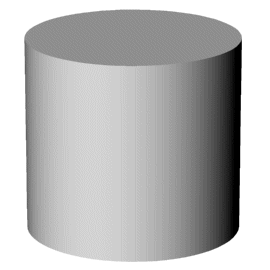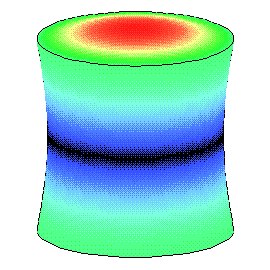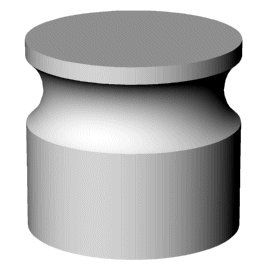A spool horn is an unslotted cylindrical horn in which the sides have
been undercut behind the face to form a spool shape. This spool shape improves the face
amplitude uniformity. Because a spool horn does not have slots, its stresses are much
lower than comparable slotted cylindrical horns and
machining costs are much lower. Spool horns generally about 1:1 gain, although somewhat
higher gain is possible. Spool horns are used for plunge welding and, occasionally, for
liquid processing.
Example
The following example shows a 20 kHz 5" diameter horn. The axial resonance is the
desired resonance. The horn is one half-wavelength long at axial resonance, as indicated
by the single node that is generally transverse to the principal direction of vibration.
For all images, the output surface (face) is at the top and the input surface is at the
bottom. The warmest colors indicate the highest amplitudes. The darkest color traces the
axial node(s).
All results are from finite element
analysis.
Original design
The following shows the original (unoptimized) design and the resulting amplitude
distribution.
 |
Original design -- No optimization |
| |
|
 |
Axial resonance, relative amplitudes -- The
amplitude is much lower at the outer face than at the center. This will cause
under-welding at the outside or over-welding at the center. View
actual vibration
|
Improved design
The following shows an improved design that has substantially better amplitude
uniformity across the horn's face.
 |
Improved design -- Uses
optimized cavity, slots, and back extension
|
| |
|
 |
Axial resonance, relative amplitudes
-- The amplitude is now very uniform across the horn's face.
View actual vibration
|
Design considerations
In order to preserve the face amplitude uniformity, spool horns cannot have any
significant face cavities.
Size limitations
As the horn diameter increases, the face radial amplitude also increases quickly. If
the horn is used for plastic welding, this radial motion can cause marking of the part.
Because of an adjacent secondary resonance (next image), the maximum horn diameter is
limited to about 0.55 * wavelength (about 5.5" at 20 kHz). Above this size, the horn
must be slotted. See slotted cylindrical horns.
At diameters near 0.4 * wavelength, an adjacent asymmetric resonance can cause poor face
amplitude uniformity. Therefore, special design techniques are required for these
diameters.